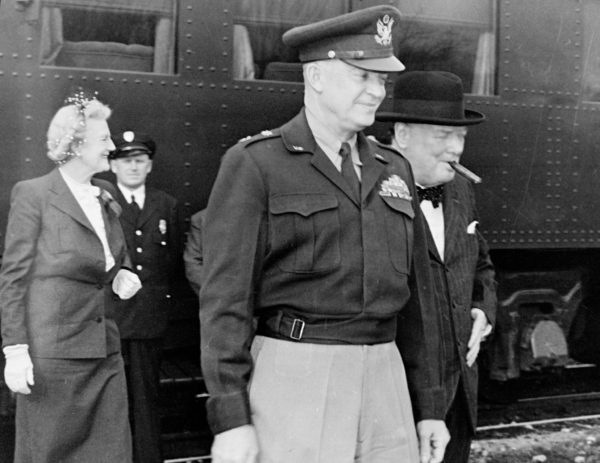
On this day—March 8—in 1946, just months after the end of the Second World War, two unmistakable figures stepped off the train together just behind the Governor’s Palace.
One, wearing his trademark short olive-drab coat and khakis, was five-star General Dwight D. Eisenhower. By his side, the British Bulldog himself, 71-year old once-and-future Prime Minister Winston Churchill, with his ever-present cigar pressed between his lips.
Just three days earlier, in Fulton, Missouri, Churchill had delivered what quickly became known as the “Iron Curtain” speech, warning of the imminent threat of Soviet domination of Eastern Europe: “From Stettin in the Baltic to Trieste in the Adriatic, an iron curtain has descended across the continent.”
“We must never cease to proclaim in fearless tones,” he declared, “the great principles of freedom and the rights of man which are the joint inheritance of the English-speaking world.”
And then he proceeded to the place that did so much to advance those principles, and where Americans initiated the call for independence: Williamsburg.
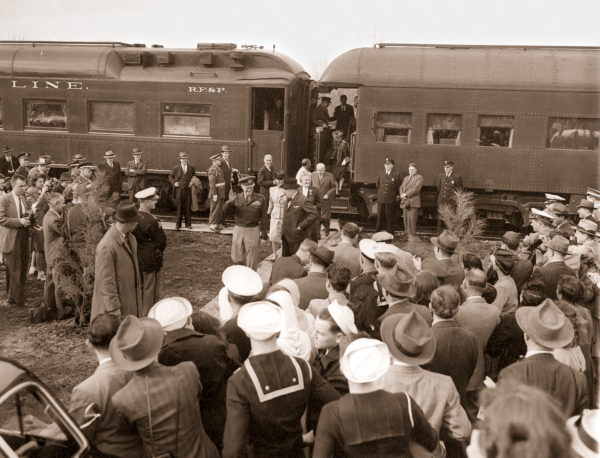
Friday, March 8 started early for the group traveling to Richmond, then Williamsburg. Their special train pulled out of the station in Washington, DC at about 2:40 a.m. They slept on the train. In the morning Churchill and Eisenhower were the stars of a three-mile parade route to their speaking engagement before Virginia’s General Assembly. Initial plans for them to speak from the colonial capital of Williamsburg were scratched for logistical reasons.
The train deposited the travel party to the spot along Lafayette Street behind the Governor’s Palace shortly after 1 p.m.
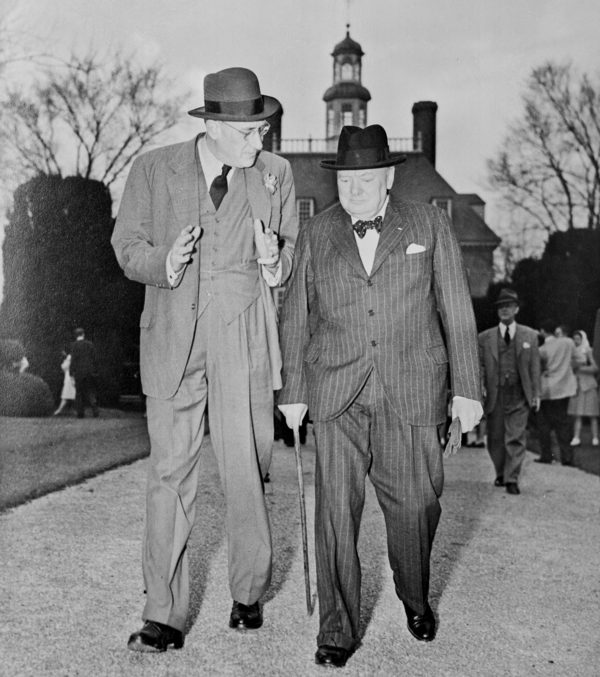
A substantial crowd, including Williamsburg Mayor Channing Hall and the city council, offered a lively welcome as the passengers disembarked and made their way into a small fleet of waiting cars.
The entourage included Winston’s wife, Clementine, and his daughter Sarah, Mamie Eisenhower, and a host of dignitaries from the British and American military and government. (And Churchill’s bodyguard, an inspector from Scotland Yard.)

The first stop was the Governor’s Palace, where the VIPs toured the building and grounds where Virginia’s royal government rose through the 18th century and fell dramatically in the Revolution.
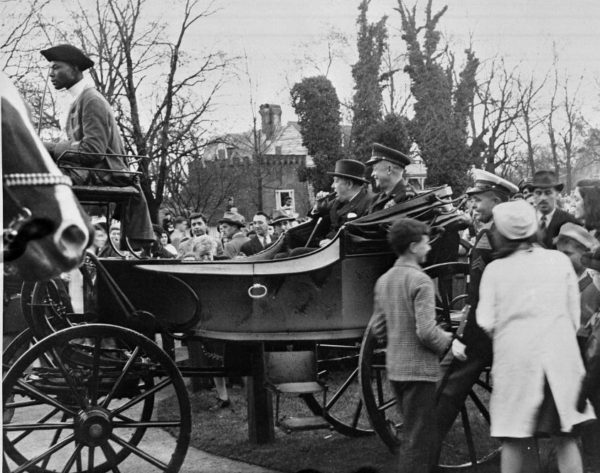
Boarding horse-drawn carriages, the plan was to head down Palace Green and east toward the Capitol. Then they would return the length of DoG Street for visits at Bruton Parish Church and the Wren Building.
At least one of the horses, however, did not exhibit the same calm under pressure as the famous passengers.
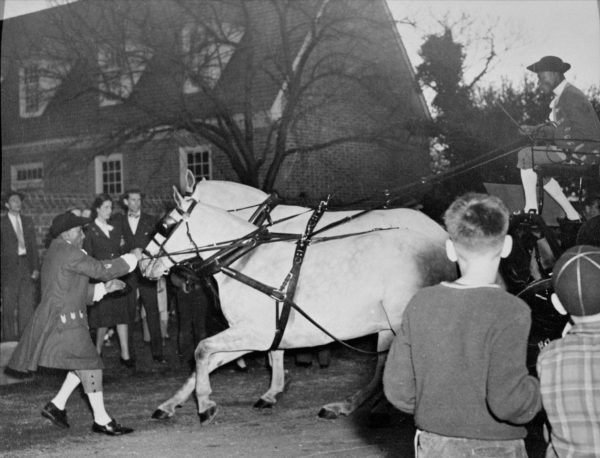
Spooked by a continuous flash of cameras, the horse offered enough resistance to break the hitch and send a few bystanders to the ground. So plans were altered, and they walked a short way down the Green to the George Wythe House.
After touring the church, they tried their luck with cars. (In those days, of course, Duke of Gloucester Street was still completely open to vehicle traffic.) The scenic ride brought them down to the Capitol, then back as far as the Raleigh Tavern, where they stopped for tea.

The evening concluded with a dinner at the Williamsburg Inn hosted by John D. Rockefeller, III and his wife, Blanchette. Guests enjoyed turtle soup, Virginia ham, and fried chicken with cream gravy, along with assorted side dishes.
Toasts were offered, celebrating the “special relationship” between Great Britain and the U.S., a phrase that Churchill was using repeatedly to argue for the importance of maintaining the nations’ close ties, which, after all, dated to the founding of Jamestown (with the occasional difference of opinion, of course).
Appropriately, the menu included a choice cigar: Dunhill’s Monte Cristo, Number 3.
The evening concluded with a candlelight tour of the Capitol. Around midnight the whirlwind tour ended, with Winnie and Ike, having feasted on the history and hospitality that has made Williamsburg famous, made their way back to that modern capital, Washington.
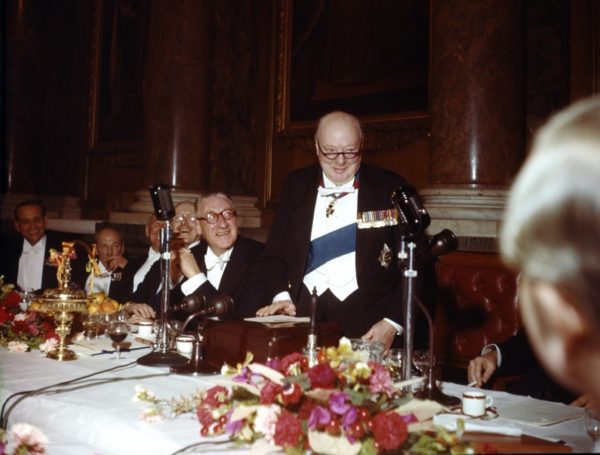
Churchill never returned, but in 1955, in a special ceremony in London, Colonial Williamsburg presented him with a handcrafted town crier’s bell made by Colonial Williamsburg’s silversmiths to honor his contributions to preserving liberty. The honor, now known as the “Churchill Bell Award,” is bestowed occasionally on people who have made extraordinary contributions to the values espoused by the foundation. It was most recently given to Colin Campbell upon his retirement as Colonial Williamsburg’s president in 2014.
Thanks to Colonial Williamsburg’s Archives Department for providing resources to share the story of this visit. The story also benefited from a wonderful in-depth book about their visit, which includes extraordinary photographs you won’t see anywhere else. The book is “Churchill & Eisenhower, Together Again: A Virginia Visit,” as chronicled by Frank A. Dementi and retold by Dr. Brian A. Dementi.
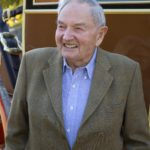
Pat says
Thank you for the great pictures of 2 great men! I did have to smile at the descriptions of Churchill’s one bodyguard and it’s reminder of simpler and safer times.
Oh, please, don’t be “that” gal, okay?
Lauren Bailey says
So, why did we not have a post about some of the great women our country has produced on International Women’s Day. I must say that this is very much a disappointment, especially after the post on all the new programs for Women’s History Month.
I am so tired of divisiveness - the “if you’re not going to talk about my cause then you can’t talk about anything.” And I, by the way, am a woman who has experienced prejudice and uneven playing fields. I say THANK YOU for reminding us of two of the heroes of WWII who helped preserve civilization - and the foundation of freedom from which we continue to work for liberty and equality for all. Let’s ditch the categories and labels, folks, and work for equal rights for ALL. There is a reason Justice wears a blindfold.
Great story! Makes you think about the visits my family and I have made to CW and stood on the same ground and pondered the same things as these two great men of history. As always CW is a jewel in the crown of America.
Very interesting’ but the second picture of Ike & Churchill in the car is backwards.
Enjoyed the story.
Thanks for pointing that out. We’ve corrected that.
I really enjoyed reading this!! I am a lover of history!!! Thank you for sharing!!!
Great read, and glad to get more information - and a picture! - about the affair with the horse and carriage. As I recall, Ike and Churchill were quite calm about it, but it must have given the Scotland Yard bodyguard and Ike’s security heart failure!!! “General Eisenhower recalled how “Sir Winston didn’t pay any attention [to the frightened horses], he just lit his cigar.” ” https://rocklib.omeka.net/items/show/650 “When the bulbs flashed, the horses reared and tried to bolt. Churchill puffed harder on his cigar and held up two fingers in his victory gesture. Eisenhower grinned. Strong men subdued the horses. Churchill and Eisenhower resumed their tour afoot. ” https://www.newspapers.com/newspage/211375767/ I LOVE the details!